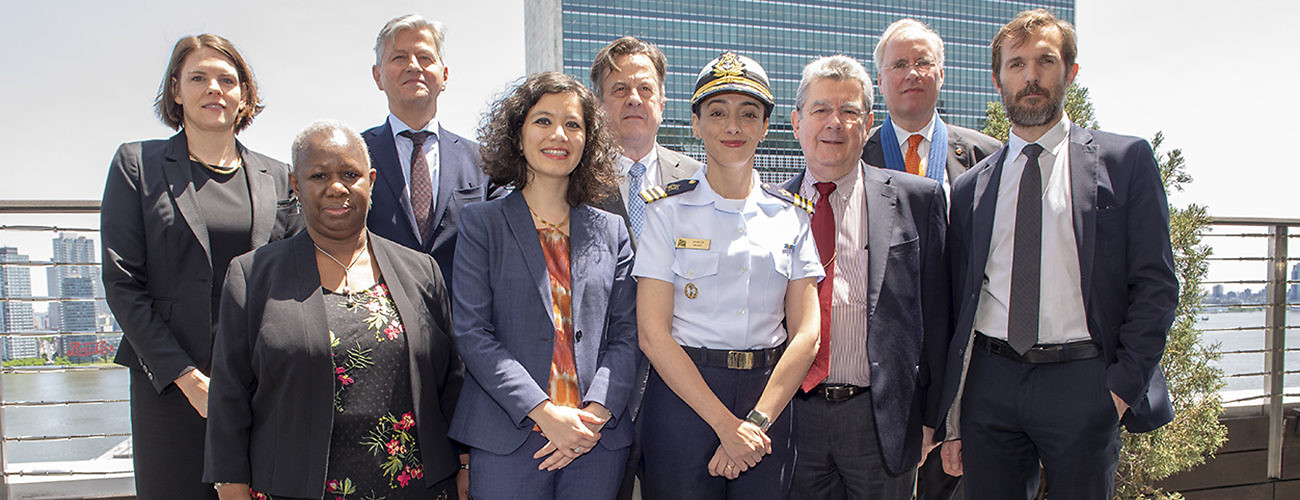Twenty years ago, the United Nations Security Council established the first explicit Protection of Civilians (POC) mandate, resolving that the UN peacekeeping mission in Sierra Leone afford protection to civilians under imminent threat of physical violence.
On May 22nd, during the week in which the Security Council held its annual POC open debate, IPI, in partnership with the Center for Civilians in Conflict (CIVIC) and the Permanent Missions of the Netherlands and of Uruguay to the UN, held a policy forum taking stock of these two decades of direct attention to POC in peacekeeping operations. The event provided an opportunity to explore the progress made and the reforms that are still needed to ensure the protection of local populations relying on peacekeepers.
“We know that peace operations have striven to do more to protect, but they are also facing many challenges,” said IPI Senior Fellow Dr. Namie Di Razza. “Peacekeepers are being asked to do more with less…and a number of reviews have highlighted persistent shortcomings and a general lack of accountability for POC.”
Since 1999, 14 missions have been mandated to protect civilians from physical violence, and today eight of the fourteen active UN peacekeeping operations have a POC mandate, constituting the vast majority of civilian and uniformed personnel deployed to these operations around the world.
Speaking to the centrality of POC to peacekeeping, Jean-Pierre LaCroix, UN Under-Secretary for Peacekeeping Operations, said, “I would argue that all peacekeeping operations, whatever the mandate, ultimately are about the protection of civilians…POC, in addition to being one of the greatest achievements of peacekeeping, is probably our greatest challenge as well.”
In meeting that challenge, he said, one had to be conscious of the outside expectations and the inside limitations. “We are never able to put peacekeepers in every village, in every location, in every place where civilians are under threat,” he said. “But by being deployed, we create and raise expectations to a level that is very difficult to meet in practice.”
He said that peacekeeping missions had developed a number of tools to acquire the “situational awareness” necessary for advancing the protection agenda in peacekeeping environments. “We engage better with local communities to have better information to be able to better deter, prevent, and preempt threats, and making sure that we can, if needed, react before these threats come to the civilian population,” he said.
Karel Van Oosterom, the Permanent Representative of the Netherlands to the UN, listed ten points that he said reflected that “we have to do more.” Among them were the need to internalize POC as standard operating procedure, to improve and expand the training of peacekeepers in protecting civilians, and to make sure that the host country takes primary responsibility. He also stressed that resources had to be sufficient to make POC an “achievable result.”
David Gressly, Deputy Special Representative for Operations and the Rule of Law, UN Organization Stabilization Mission in the Democratic Republic of Congo (MONUSCO), spoke of the successive generations of POC practice. He stressed the importance of telecommunications in “reinforcing the intelligence architecture” so peacekeepers can track threats before they develop into armed conflict. He particularly stressed the innovations pursued by the peacekeeping mission in the DRC, where 65 community alert networks were established, and cover more than 900 communities. He explained the value of protection through presence and projection, as “showing up and being there…[causes] an immediate freezing of the situation.” He added, “We need to end the conflict, that’s the ultimate protection.”
Bintou Keita, Assistant Secretary-General for Africa, UN Departments of Peace Operations and Political and Peacebuilding Affairs, said that including women was a crucial element of protection of civilians activities. To illustrate the point, she told a story about her work for the peacekeeping mission in Darfur (UNAMID) that was suddenly overwhelmed by thousands of internally displaced persons, most of whom were women and children. “On the day when we arrived, we came to a place where it was important for women to be there,” she said. “Most of the peacekeepers were men, they could not go and engage and see within the site what was happening with women because they had to protect their privacy.”
It was also a situation that required the attention of humanitarian workers, and Ms. Keita said, “Another aspect of protection is having all humanitarians and all components of the mission in one meeting.”
The importance of having women involved in POC also figured in the remarks of Lieutenant Commander Marcia Braga, former Military Protection of Civilians and Gender Adviser, UN Multidimensional Integrated Stabilization Mission in the Central African Republic (MINUSCA). “When I have female peacekeepers, it’s a little bit easier to talk about the special needs of different groups. Our presence is less offensive, and we can approach the local population, which is very important.” Having this kind of engagement with the local population built up the level of acceptance by them and made it easier for the peacekeepers to protect them, she said.
Alison Giffen, Director, Peacekeeping Center for Civilians in Conflict, lamented that international enthusiasm for peacekeeping was declining and warned against shortchanging peacekeepers. “If we’re going to issue mandates to protect civilians, we have to give them the means,” she said. “That’s not just the trained troops and civilian personnel. It’s not just the capabilities and the enablers. It is the financial cost of peacekeeping. Protecting civilians has a cost. It is an investment worth making.”
In concluding remarks, Elbio Rosselli, Permanent Representative of Uruguay to the UN, commented, “We also have to remember that armed protection is not necessarily the only way of protecting civilians. Unarmed methods are incredibly effective.”
Jake Sherman, Director of IPI’s Brian Urquhart Center for Peace Operations, made welcoming remarks, and Ms. Di Razza moderated the discussion








